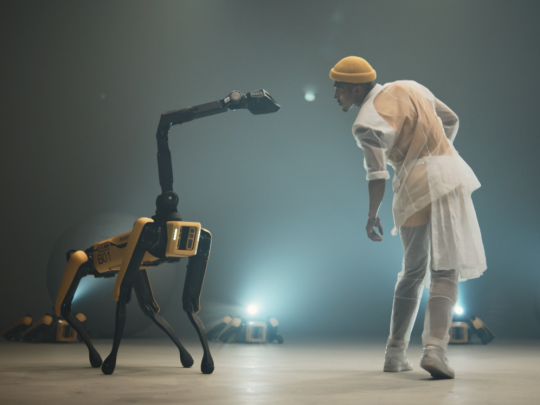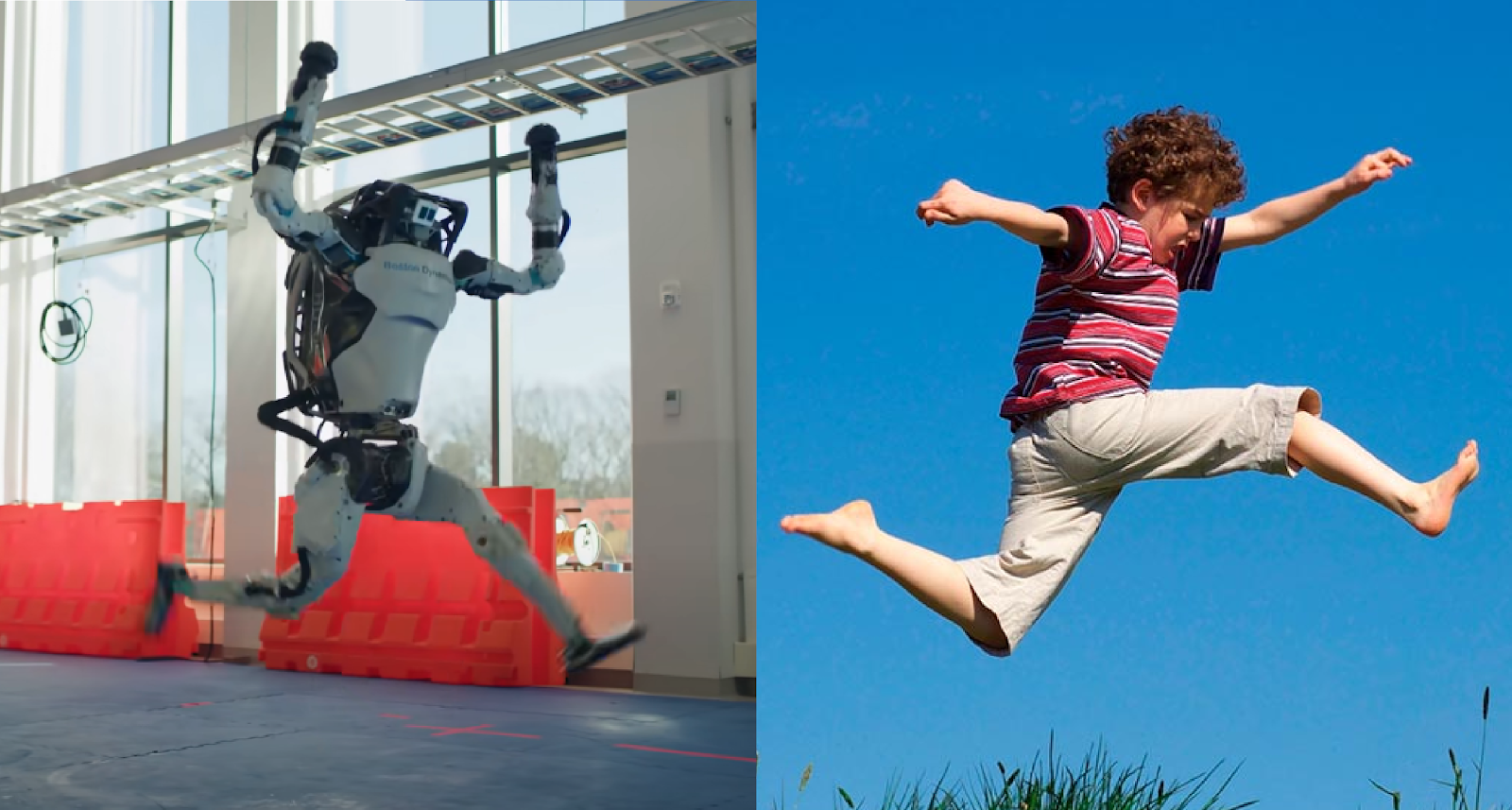
In science fiction, especially in the classics of mid-century American writers, robots are very common. Most often they help a person, sometimes they live by themselves, and sometimes they even fight with the people who created them. But almost always - these are upright anthropomorphic machines, with two legs and with two arms. It's surprising how persistently film writers and screenwriters try to endow machines with human features.
Modern robots are much more practical, they are maximally adapted for some narrow task and look as unlike humans as possible.
But there is one company that, despite all considerations of practicality, creates robots that are as similar to humans and animals as possible - Boston Dynamics. And recently they taught their robot to dance!
See this video under the cut.
Despite all the difficulties and numerous resale of the company in different hands, BD does not lose heart. She has ambitious plans. Scientific research goes hand in hand with commercial activities, as evidenced by a fiery video that literally blew up the Internet a couple of weeks ago, on New Year's Eve. At the moment, it has more than 25 million views, and its popularity has not subsided.
This is not computer graphics, the video is made with real robots that actually do exactly what is seen on the screen. The first two minutes were filmed in one frame, without gluing or editing. Even the entourage is specially chosen to emphasize maximum realism. This is not a chromakey or glamorous scene. This is an unadorned laboratory test room, behind the glass of which you can see some kind of machines and mechanisms, ordinary workplaces, markings on the floor for a videographer.
Graceful movements, high jumps, synchronized actions - all this perfectly demonstrates the capabilities of modern robotics. How did Boston Dynamics (BD) achieve this success? In this article, I offer you a quick tour of the company's history, its successes and failures, and also a little about how this robot dance was filmed.
As a child, I read a science fiction story in which an engineer created self-replicating and self-learning robots, and they started a small war among themselves, fighting for high-tech resources for an upgrade. In this story, I remember one detail: the first robot, having gained independence, replaced the practical anti-gravity drive with primitive legs, like that of its creator. The engineer was categorically against, but the robot did not listen to his arguments. Subsequently, this played a cruel joke with the robot: he stumbled during the battle and was crushed by his relatives, which would not have happened if he had left the antigrav.
Almost all modern robots, on wheels or on tracks, are simple and reliable. There are no problems with balance, operation is most often limited to rooms with a flat floor.

The robots in the Amazon
BD warehouse decided to make a science fiction dream come true:

Robot Atlas
How it all began
The evolution of humans and animals has clearly demonstrated how universal limbs are. With their help, you can walk, run, climb mountain slopes and tree trunks, step up stairs. Primates have gone the farthest in this versatility.
For a long time, upright posture was not given to engineers. Gyroscopes were too bulky, analogs of a compact vestibular apparatus with feedback could not be created due to the primitive electronic technical base. But the advent of affordable microcontrollers has made this engineers' dream come true. Of all the collectives involved in walking robots, Boston Dynamics is best known.
The inspiration and permanent leader of this laboratory is Mark Reibert .

Mark Reibert
In 1973 he graduated from Boston Northeastern University with a degree in Electrical Engineering, and in 1979 received a grant to develop the first Jumping Machine, from the famous American scientist and inventor Ivan Sutherland .
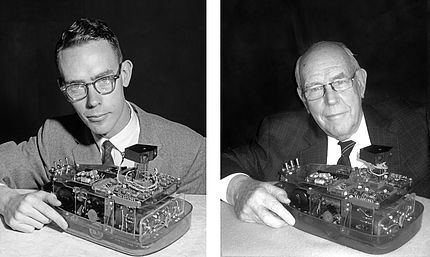
Ivan Sutherland
In 1980, he managed to interest DARPA (then still ARPA)in his development , received the first funding from them and opened the Leg Laboratory. It was originally located at Carnegie Mellon University, where Mark worked as a professor, and then, after him, moved to Massachusetts Institute of Technology.
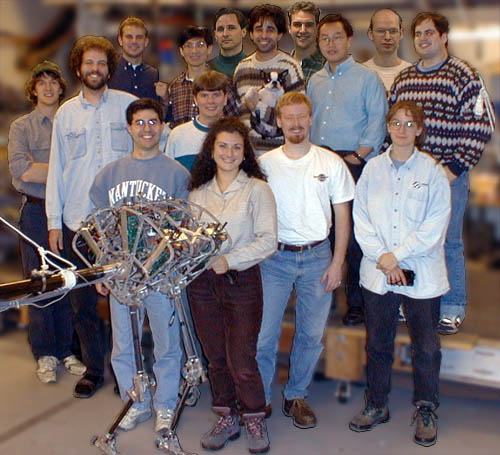
Leg Laboratory
The MTI website still has a page of this research team, created long before modern design and web development trends. The warm and tube- like web1 looks pretty touching. I highly recommend to follow the link and see where the history of this famous scientific team began.
In 1983, their development was ready under the name "3D One-Leg Hopper":

The one-legged jumper could balance or move by jumping in a given direction and maintain balance if they tried to drop him. An unusual method of movement was chosen because it is easiest to calculate balancing on one leg.
In the next video, you can watch the robots created at the Leg Laboratory. All of them are purely research mechanisms, without any practical value, created exclusively for the study of the work of joints, drives on a different principle of operation and mathematical algorithms of movement. Some are part of more complex designs. Some of them are not able to maintain balance on their own and move with the help of a counterweight bar. "Naked" robots bring to mind the movie about the Terminator, and the laboratory interiors - the workshop of Jaime and Adam from "Mythbusters"
Mark expressed his accumulated research experience in his book Legged Robots That Balance , published in 1986.
From laboratory to company. Work for the military
Time does not stand still. To gain more financial independence, Mark decides to leave the University in 1995. He finally leaves for his own company, founded in 1992. The name of this company is now heard even by those who are not interested in modern technology, thanks to spectacular videos showing the achievements of modern robotics: Boston Dynamics .
As at the very beginning of his career, Mark receives funding from the military. DARPA gives his company the assignment to develop a "working mule" that can carry significant loads in areas where conventional vehicles cannot pass. According to the TK, the robot must be able to climb, overcoming a significant slope, overcome thickets of bushes, pass on slippery and loose surfaces, that is, be able to do everything that an infantryman or ... a mule is capable of.
Completing this assignment was not easy. Only in 2005 was the BigDog model introduced .

The project was extremely ambitious. It was the first such plan to be developed and its media success exceeded all expectations. The news about the robot could be heard from every iron, and many videos received record views.
Until now, the most widely known models of walking robots were purely entertaining products when moving, clumsy and clumsy. They fell from the slightest shock, and could only move on a perfectly flat floor. But BigDog looked like a machine from the future, versatile and practical. People were mesmerized by the spectacle of an autonomous mechanism walking like a living creature and capable of carrying a significant load. The brainchild of Mark's company was fully consistent with the legend of the legendary Arthur Clarke: "Any sufficiently advanced technology is indistinguishable from magic." It even got to the point that people filmed parodies of this mechanical creature:
Unfortunately, the robot was technically not as successful as the video suggests. Even the second generation, released in 2008, had too many flaws. In 2013, the US Department of Defense refused to continue this program. One of the main problems was the strong and unmasking noise of the internal combustion engine, which the engineers could not get rid of. The second problem was that, despite the formal implementation of the TK, the characteristics of the robot were still insufficient to fully participate in real combat missions. The passability was impressive, but the military lacked it. Autonomy was only 30 km, the robot traveled this distance at the speed of a pedestrian. Since the robot was technically extremely complex, the prototypes had serious reliability problems.The first versions barely withstood half an hour of continuous work before something broke in the mechanism, and it became incapable of further functioning. The latest robot models worked confidently for up to three hours, but this is still extremely small, and it is almost impossible to repair such a complex device in the field. The breakdown would jeopardize any real combat operation if it had high hopes for this assistant. In addition, the robot was very, very expensive to manufacture.The breakdown would jeopardize any real combat operation if it had high hopes for this assistant. In addition, the robot was very, very expensive to manufacture.The breakdown would jeopardize any real combat operation if it had high hopes for this assistant. In addition, the robot was very, very expensive to manufacture.
Nevertheless, although the development of this model was abandoned, the military did not stop working with BD. As research continues, several more varieties of walking, running, even jumping and crawling robots have been released.

On the curbstone stands Little Dog (BigDog's younger electric brother), Spot, BigDog, WildCat, LS3 (BigDog's older military brother)

SANDFLEA - Flea.
A baby robot (15 cm high) capable of jumping over two meters with a can of compressed gas.

RHEX.
About the size of the SANDFLEA, it can climb over small obstacles and crawl even in swampy terrain.
Financial questions
Working with the military, the company changed hands several times. At the end of 2013, Google bought the company. It's hard to say why they did it. Perhaps just in the process of buying up different companies along with several other robotics companies and startups, perhaps in pursuit of patent portfolios and relying on profit. During the collaboration, BD and Google could not find a common language. After Google left Andy Rubin, who initiated the transaction, the future of the company was suspended. Andy himself said that he was disappointed with the speed of development, because even preliminary research took a very long time. The Internet giant did not want to invest so much money in a company whose commercial results have to wait 10 years or more. In addition, the video of the latest humanoid robot being pushed and knocked down was disliked by Google's advertising department.
(At 1.22, the robot is pushed with a club and "selected" the box, at 2.04 it is knocked down with a push in the back)
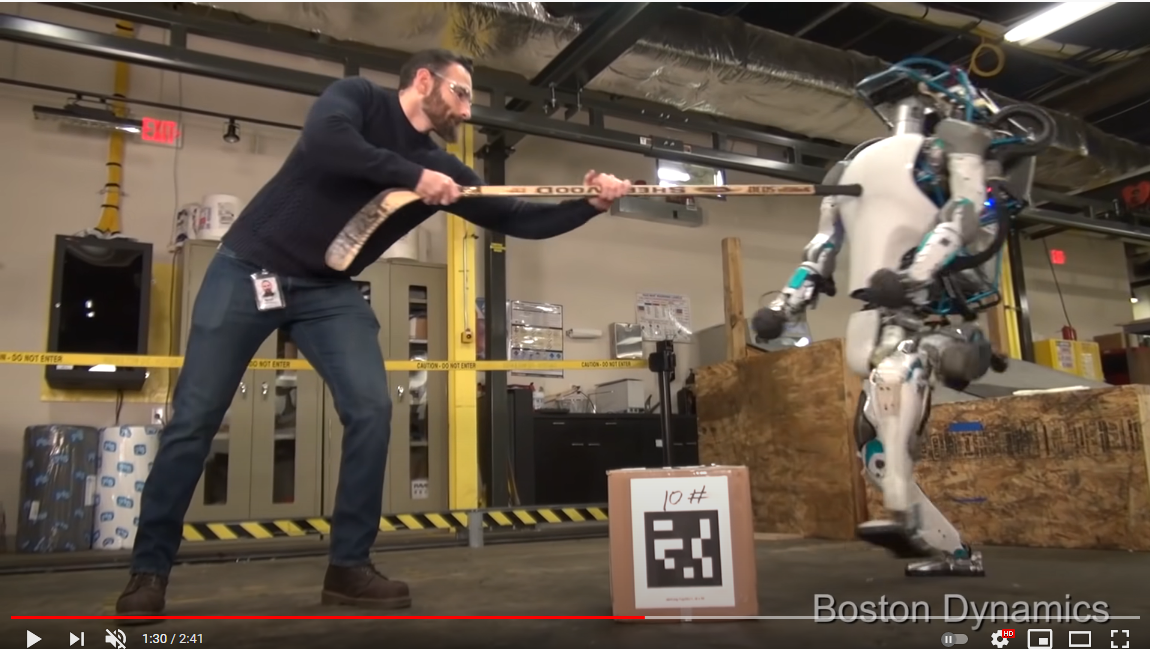
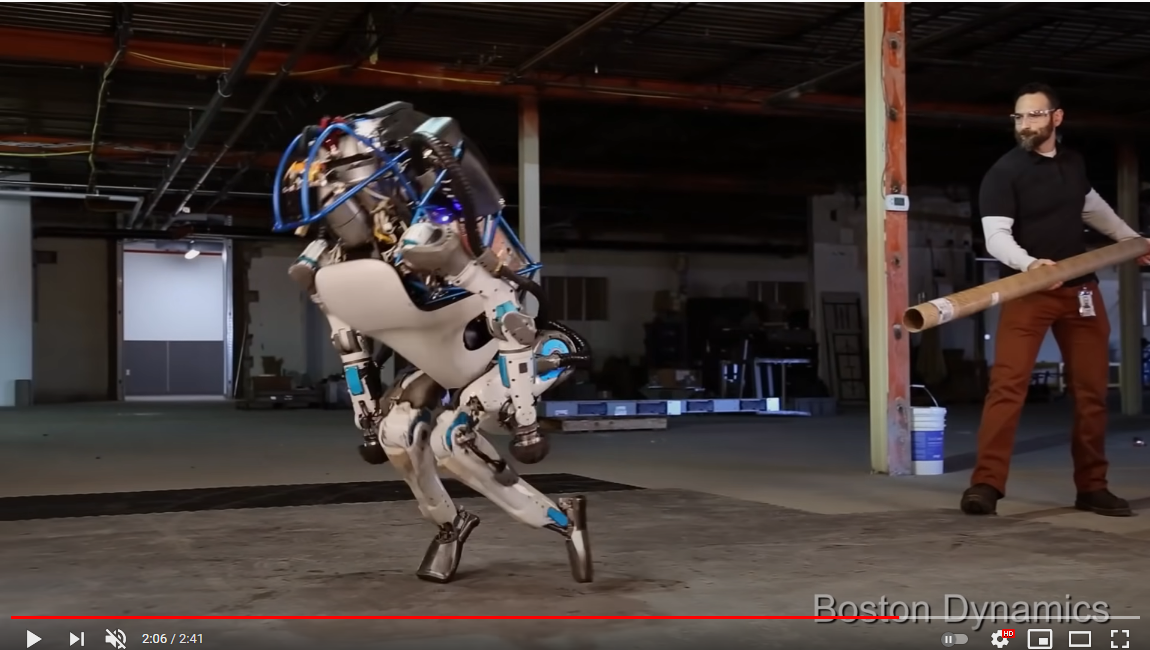
In addition, the anthropomorphic nature of the robot aroused amazing empathy among the audience, who saw in the demonstration of balance algorithms - mockery and sympathized with the robot.
A letter written by the head of the PR department of Google Courtney Hone got on the Internet , in which she writes that humanoid robots annoy people by the fact that they see them as a threat, as if these robots are able to take their jobs. Finally, in 2016, Google decides to sell BD. According to rumors, Amazon and Toyota wanted to buy the company. As a result, it went to the Japanese holding Softbank.
The financial adventures of BD did not end there. More recently, it became known that the company is once again for sale. In December last year, Softbank and Hyundai agreed on a modest sum of about $ 1 billion.
Nevertheless, all this did not prevent the development of new robots. In addition to Atlas, which was mocked with a club, a robot with a hybrid mode of movement was developed: the Handle. The legs of the robot end with wheels that allow it to quickly move on a flat surface, descend stairs. He can even jump if necessary.
First commercial model
More recently, a section with a store was opened on the company's website , and BD, for the first time in almost 30 years, offers a commercial model: Spot. Despite the dog's name (Spot - a speck), the robot is offered for commercial use in industrial facilities and is not intended for domestic use. The modest dimensions (the robot is slightly larger than the German Shepherd Dog), suggest modest possibilities: only an hour and a half in active mode, while the battery charges for two hours.

The design was done very well. The robot no longer resembles the Terminator and moves quite gracefully, its limbs do not treadmill, like in previous versions of four-legged robots. Base price - $ 75,000. It is difficult to say whether this is a lot or not, because you can count such offers on the market on the fingers of one hand. Despite the pandemic and the general recession, the company says it has produced about 400 robots of this model and is not going to stop there.
Dance
After remembering the history of the company and considering some models of robots, you can talk a little about how the incendiary dance was created. To do this, I prepared an abridged version of an interview with Aaron Saunders , vice president of engineering at Boston Dynamics, taken from him by the IEEE Spectrum magazine, published by the American Institute of Electrical and Electronic Engineers .
The rock'n'roll single featured in the video was recorded by The Contours in 1962. The song "Do You Love Me" is one of their most famous works. The choreographer was Monica Thomas from MAD KING THOMAS .
Until now, BD robots and engineers had never done anything like this. The range of movements available includes many elements of walking, running and jumping, some exercises from gymnastics and even parkour. But no one has tried to make the mechanisms dance yet. Initially, the dance was created using a computer simulation program, in which human dance movements were adapted to the physical capabilities of robots. After selecting a particular movement, the simulation was shown to the engineers. They looked at the screen and said something like: "It will be easy!", Or: "It will be difficult!", Or: "This scares me!" As we worked on the project, a set of tools was developed with the help of which the ballet movements of the robots were programmed at a high level. Thus, the dance shown in the video is not a script,where all the smallest details are manually recorded, this is the product of a software pipeline that combines separately developed elements and transforms them into an array of data, which are then loaded into the machine.
The most difficult thing was to program the rotational movements, because they are most different from the elements that are used when running and jumping. However, the dexterity and balance required to perform the movements already practiced proved to be sufficient for programming the dance. Prior to this experiment, the main emphasis was on leg movement, jumping and running. In this case, the lower part of the body of the robots is most used. The next step in increasing the complexity of behavior patterns is to develop dance movements, using the hands to push or pull. One of the new challenges for the team was to expand mobility with the robot's upper body.
Atlases do not use machine learning controllers, but they use what the company calls reflexive control (predictive controllers that work with predictive models that take into account dynamics and equilibrium, optimizing the trajectory in online and offline modes).
This experiment made it possible to learn a lot about the robots' reliability and their capabilities. The commercial robot Spot, in contrast to the purely research Atlas models, was designed for continuous operation. He showed excellent results and could dance all day long with almost no maintenance. Only a few copies of the atlases have been made; they are not intended for long-term and continuous operation. In this respect, they are more like a helicopter, which has more preparation and maintenance times than flight times. A spot is more like a car that drives more than it serves.
Atlases had to be specially modified for this program, increasing their power. Although the tricks and jumps that these robots demonstrate are very sharp, the dance moves require even more speed and strength.
It is difficult to say how the company will develop further. Mark himself is no longer young, he is 71 years old. Google was unable to find commercial potential in BD. When Softbank bought the company, the amount of the deal was not disclosed, so it is difficult to say whether the sale of BD to the Korean auto giant was profitable or not. It seems that no special commercial successes were observed during the time that the company had with Softbank. Hyundai hopes to use the company to develop autopilots in its cars and to automate production. Maybe she can get practical benefits from the alliance with BD.
The fact is that Mark and his colleagues are Scientists, with a capital letter. They do research in its purest form, without thinking about monetizing their knowledge. The theoretical knowledge gained over thirty years is enormous. It is very difficult to say whether they will find practical application in the near future. Although it seems that this is applied engineering research, the works on which lay unclaimed for centuries, that are far from theoretical physics and higher mathematics, they have much in common. For example, one of the main restrictions is nutrition. Experimental Robot Cheetahwas not even thought of for stand-alone use. It was a test bench for technology break-in, not working without a permanent connection to the outlet. For Big Dog, the main problem was the internal combustion engine, for Pyatnyshka autonomy (only an hour and a half, even excluding attachments), and speed like a pedestrian.
Maybe the use of machine learning in controllers will lead to another technical breakthrough, maybe they will invent more capacious and compact power supplies. The future of the company is difficult to predict. Let's wish them good luck!
